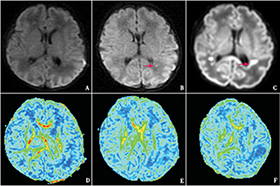 PDF(1824 KB)
PDF(1824 KB)


 PDF(1824 KB)
PDF(1824 KB)
 PDF(1824 KB)
PDF(1824 KB)
早产儿微小型脑白质损伤的MRI-DTI评价
MRI-DTI evaluation of punctate cerebral white matter damage in preterm infants
目的 应用磁共振弥散张量成像(DTI)对不同程度的微小型脑白质损伤(CWMD)进行评价, 探讨DTI 在早产儿CWMD 中的应用价值。方法 选取2011 年11 月至2012 年4 月住院治疗的31 例早产儿, 分为局灶性CWMD 组11 例, 广泛性CWMD 组10 例, 同时正常对照组10 例, 比较三组患儿侧脑室旁的表观弥散系数(ADC)值及各向异性(FA)值, 应用Pearson 系数检验ADC 值及FA 值变化的相关性, 同时观察三组患儿的彩色FA 图。结果 局灶性CWMD 组及广泛性CWMD 组的ADC 值均高于正常组, 差异有统计学意义。局灶性CWMD 组及广泛性CWMD 组FA 值均低于正常组, 广泛性CWMD 组FA 值低于局灶性CWMD 组, 差异均有统计学意义。经过后处理的FA 彩图提示侧脑室周围白质区域的FA 值按正常组、局灶CWMD 组及广泛CWMD 组顺序依次减低。结论 弥散张量成像技术可定量评估微小型CWMD 程度。在CWMD 评价方面, FA 值比ADC 值可能更加准确。
Objective To evaluate different degrees of punctate cerebral white matter damage (CWMD) using diffusion tensor imaging (DTI), and to investigate the value of DTI for CWMD in preterm infants. Methods Thirtyone preterm infants who were hospitalized in the Shengjing Hospital of China Medical University between November 2011 and April 2012 were enrolled and divided into focal CWMD (n=11), widespread CWMD (n=10), and normal groups (n=10). The apparent diffusion coefficient (ADC) and fractional anisotropy (FA) values were determined in the periventricular regions of patients in three groups, and comparison of the two indices between the three groups was performed using one-way analysis of variance. The correlation between the changes in ADC and FA values was analyzed using the Pearson coefficient, and the color-encoded FA maps in the three groups were evaluated. Results The ADC values in the focal CWMD and widespread CWMD groups were both significantly higher than in the normal group, while the FA values in the focal CWMD and widespread CWMD groups were both significantly lower than in the normal group. The FA value in the widespread CWMD group was significantly lower than in the focal CWMD group. The colorencoded FA maps after post-processing indicated that the normal group had the highest FA value in the periventricular white matter regions, followed by the focal CWMD group and the widespread CWMD group. Conclusions The DTI technique can quantitatively evaluate the degree of punctate CWMD. The FA value may be more accurate than the ADC value in the evaluation of CWMD.

微小型脑白质损伤 / 弥散张量成像 / 表观弥散系数 / 各向异性分数, 早产儿
Punctate cerebral white matter damage / Diffusion tensor imaging / Apparent diffusion coefficient / Fractional anisotropy / Preterm infant